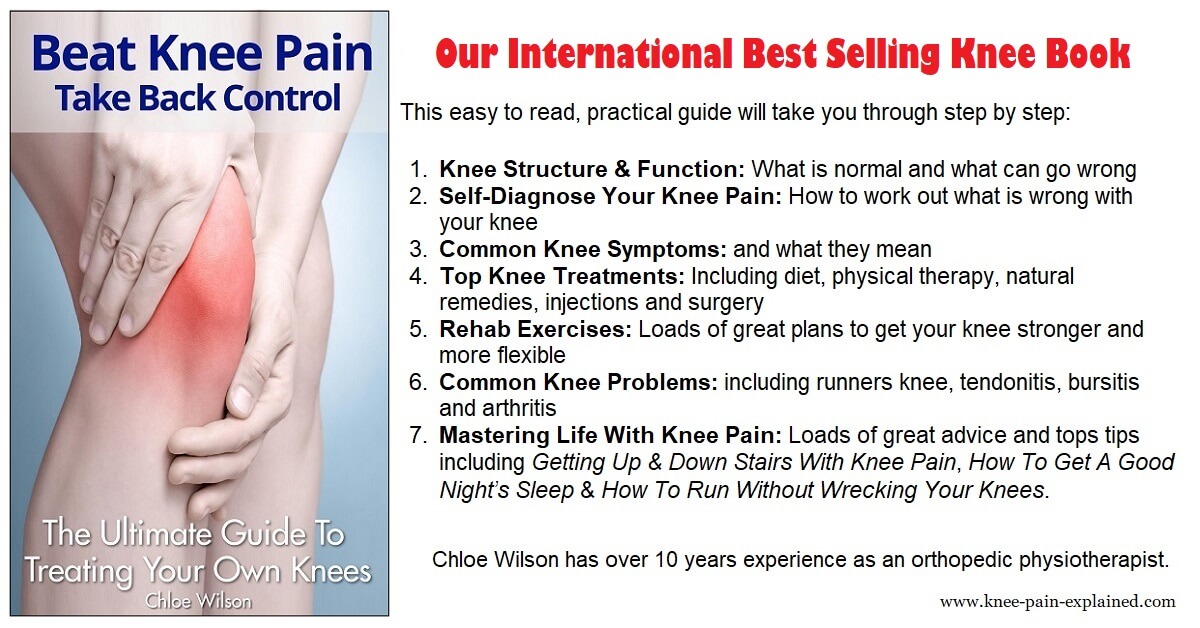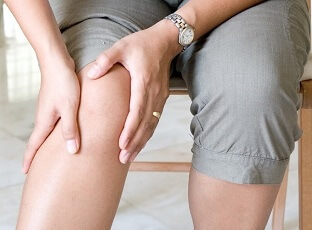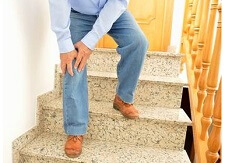- Home
- Knee Pain Treatment
- How To Do Stairs
Beat Knee Pain On Stairs
Written By: Chloe Wilson, BSc(Hons) Physiotherapy
Reviewed by: KPE Medical Review Board
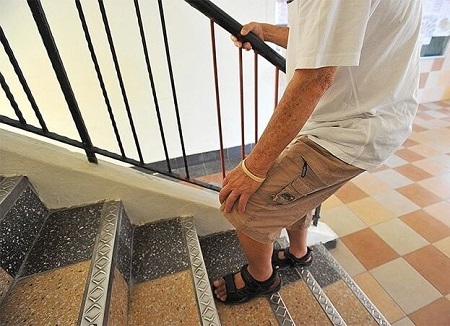
Knee pain on stairs is a really common problem.
Going up and down stairs puts a great deal of force through the knee joint and knee cap:
Going Upstairs: 2.5x bodyweight
Going Downstairs: 3.5x bodyweight
So it’s no wonder that people often find it difficult!
Getting up and down stairs requires a combination of strength, mobility, knee flexibility, balance and control and any swelling, irritation, damage or inflammation in the knee joint can easily be aggravated by stairs. LEARN MORE >
Whether your knee pain is worse going up or downstairs, starts immediately or if you've done too much, there are some simple things you can do that can make a massive difference.
People often limit how often they go up and down stairs each day to try and avoid knee pain, and some even get driven to the point of sleeping downstairs. But don’t sign up for that stair-lift just yet!
What Causes Knee Pain On Stairs?
There are a number of things that can result in knee pain on stairs. Some people find it worse going upstairs, others struggle more coming down.
Knee pain on stairs may be due to:
- Muscle Weakness: loss of strength and/or endurance in the knee muscles
- Wear And Tear: to the knee bones and/or cartilage
- Knee Injury: damage to one or more of the structures in or around the knee
- Kneecap Damage: thinning of the cartilage that lines the back of the kneecap
- Altered Biomechanics: abnormal foot position and hip angles can increase the forces going through the knee
- Inflammation: any swelling in the knee can make it difficult to get up and down stairs
It is really important to know why you are getting pain as you go up and downstairs so you can treat it properly.
Check out our article on Knee Pain Going Up & Downstairs for help working out was is wrong and what you can do to help.
How To Beat Knee Pain On Stairs
It might sound strange to think about this when you’ve been climbing stairs for years, but by making some small changes to how you go up and down, you can really reduce the stress on your knee and reduce knee pain on stairs.
1. One Step At A Time
Taking things slowly can really help knee pain on stairs. Most people only put one foot on each step, but actually going up one step at a time is much easier. By this I mean one foot moves up onto the next step, then the other joins it on the same step and so on all the way up or down.
While it might be a little slower than striding up alternating feet with each step, it can make a real difference.
2. Lead With The Correct Leg
As well as going one step at a time, thinking about which leg moves first can also really help, and it’s different depending on whether you are going up or down stairs.
- Going Upstairs: Step up first with your good leg, then follow onto the same step with your bad leg. Repeat all the way up
- Coming Downstairs: Step down first with your bad leg, then follow onto the same step with your good leg. Repeat all the way down.
A simple way to remember it is:
"Good leg up to heaven, bad leg down to hell!"
Following this order on the stairs requires less knee flexion and places less force through the affected knee so reduces knee pain on stairs. You'll be surprised how much difference it makes!
3. Use The Hand Rail
It might seem obvious but holding on to a bannister/rail can also really help reduce knee pain on stairs as you can take some of the weight through your upper body which helps reduce the weight going through the knee.
Remember, you can always stop part way up and lean on the rail/wall to give your leg a break.
4. Use a Crutch/Stick
Extra support to take the weight off your knee can really help reduce knee pain on stairs. If you don’t have any bannisters/hand rails on your stairs or only have one on one side, using crutches or a stick can help. You can use the crutch like a rail and reduce the pressure through the knee. Indeed, studies have shown that using a walking cane can reduce the forces through the medial side of the knee by 15-45%.
You want to follow the same pattern as with a rail going one step at a time, but you will also need to think about when to move the crutch.
Always start with your crutch(es) on the same step as both feet.
- Going Upstairs: Step up with your good leg, bring your bad leg on to the same step and finally bring the crutch up to the same step.
Remember the mantra “good leg, bad leg, crutch.” - Going Down Stairs: Place your crutch down on to the step below, step down on to that step with your bad leg and then bring your good leg down onto the same step.
Remember the mantra “crutch, bad leg, good leg.”

The key here is the crutch always stays with the bad leg. People’s natural tendency is to have the crutch on the higher step, but if you do that, you can’t put as much weight through it due to the angle of your shoulder. It also throws you off balance.
The crutch/stick should always be either on the same step as the other two feet or the lower step, never the higher step.
#CommissionsEarned from Amazon on qualifying purchases
5. Use 2 Crutches/Sticks
There are a couple of reasons why you might need two sticks or crutches on the stairs.
Firstly, you may not have any hand rails but need support through both arms.
Secondly, you may have 2 rails but need both sticks/crutches once you get to the top or bottom and therefore you need to take them both with you. So how can you best use two crutches or sticks if you have knee pain on stairs:
- No Handrails: If you don’t have any handrails, simply follow the same order as above for 1 stick but have a crutch/stick in each hand. The crutches always move together.
- Handrails: The easiest way to get up and down stairs with knee pain if you have rails is to use them. If you only have one rail, or have two rails but need to get 2 crutches up or down the stairs, it is easiest to use a rail on one side and hold both crutches in the other hand.
This can seem a little cumbersome but there is a good trick. Hold one crutch normally and then make a T shape with the other crutch as shown.

And here are some extra top tips for using crutches to reduce knee pain on stairs:
- Hold the extra crutch on the outside so if you drop it, it doesn’t bang against your knee or trip you up
- Have the top of the spare crutch at the front so when you get to the top/bottom, you can easily use it rather than having to flip the crutch the right way up.
If you find it difficult carrying the second crutch on the stairs, either ask someone else to carry it for you, or get a spare crutch so you keep one upstairs and one downstairs.
6. Warm Up Your Knee
Knee pain on stairs is often due to stiffness and a lack of lubrication in the knee joint. Our knees stiffen and tighten fairly quickly when we don’t use them. This is particularly the case following a knee injury or with certain knee conditions such as knee arthritis.
Our joints need lubricating, just like our cars need oil. When the knee moves, it pumps fluid around which helps to lubricate the joint. When we sit still, or lie down, the “natural oil” can dry up and when we get up, the knee can feel stiff and sore when we get up and feel even worse on stairs/steps.
People often find their knee pain on stairs is worse either first thing in the morning, or after they have spent a prolonged period of time sitting or lying down. This is because the knee joint has “dried up” and feels stiff and sore.
But by simply bending and straightening your knee for a minute or two before you get up and head to the stairs, it can feel a lot more comfortable. This simple action gives the body time to prepare and for the knee joint to produce the fluid needed to lubricate the joint and allow the knee to move freely on the stairs. It can also help to use a heat pack before exercising to increasing blood flow to the knee.
#CommissionsEarned from Amazon on qualifying purchases
7. Improve Your Strength
If the muscles that support your knee are weak, then you are much more likely to get knee pain on stairs. If the muscles can’t properly support the knee, then more force will go through the knee bones and knee cap which can lead to pain. Muscles may lack:
- Instantaneous Strength: how strong a contraction they can perform. The muscles need enough strength to be able to move the knee and support it so it doesn’t give way
- Endurance Strength: how long they can work for. The first few steps might feel ok, but if lacking endurance, the leg muscles quickly tire and work less effectively leading to more knee pain on stairs
Here are two simple exercises can really help with both.
Sit To Stand Strengthening
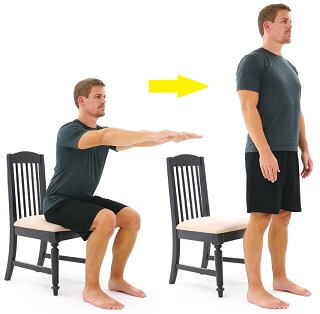
This is a really simple, functional exercise that helps reduce knee pain on stairs:
- Sit in a chair, both feet flat on the floor, arms out in front or by your side
- Bring your head and shoulders forwards, push down through your legs and stand up straight
- To sit back down stick your butt backwards, bend your knees and lower down into the chair
- See how many reps you can do in 1 minute
To make it easier: use a chair with arms and push down through the arms of the chair
To make things harder: Use a lower chair
: Increase your speed
: Don't sit all the way down each time, just perch on the chair slightly and come straight back up
Top Tip: Count how many times you go up and down, and each week try and speed up and aim to do more reps in the same time
Step Up Strengthening
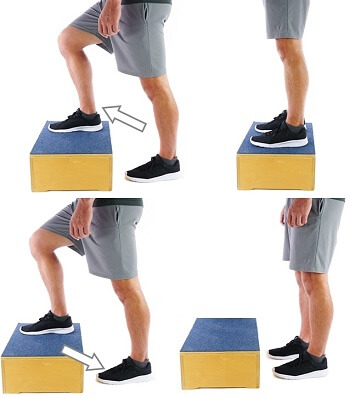
- Stand facing a single step or at the bottom of the stairs, both feet together
- Step up with your good leg and then bring your bad leg up onto the same step
- Step back down with your bad leg and then your good leg
- Repeat for 1 minute
To Make It Easier: Use a hand rail, stick or crutches
To Make It Harder: alternate which leg you step up and down with
: increase your speed
As your knee muscles get stronger, you should notice that it gets easier to get up and down the stairs. It might be that there is less knee pain on stairs, that you can get up quicker or that you rely less on the hand rail.
But stick with it – it may take around 4 weeks or so to notice much difference and things will continue to improve over the next few months so don't give up!
These are just two simple exercises that can really help to improve strength and reduce knee pain on stairs. You can find loads more exercises that can help in the knee strengthening exercises section or if you want something slightly different, try resistance band exercises for legs.
8. Improve Knee Mobility
To be able to walk upstairs normally i.e. only placing one foot as opposed to both on each step, your knee needs to be able to bend a certain amount. Generally, you need between 90-110 degrees of knee flexion to climb stairs normally. Obviously, the higher the step, the more the knee will need to be able to bend.
It is a similar story for knee extension too – weight bearing on a bent knee places much greater force through the knee joint than weight bearing on a straight knee.
If you have knee stiffness that restricts your knee flexion to less than 110o and/or prevents you from fully extending your knee, then you are likely to get knee pain on stairs and will struggle to do stairs normally. So improving the range of motion at your knee is really important. You don’t need to have full range of flexion, but aim for 0-110o. LEARN MORE >
Here are a couple of exercises that can really help to improve reduce stiffness and knee pain on stairs.
Knee Slides For Flexion
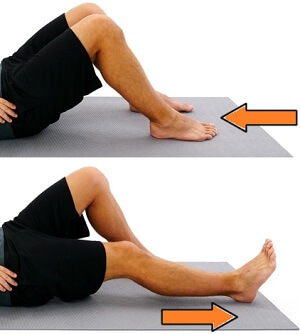
- Lie on your back, good knee bent, leg to be worked out straight
- Slide your heel towards your buttocks bending the knee as far as you can
- Hold for 3 seconds and slide your leg back down straight
- Repeat 20-30 times
Progression: In the bent position, hook your other foot over the front of the ankle. Push your affected leg back with your good foot to help bend the stiff knee further.
Prone Knee Hangs For Extension
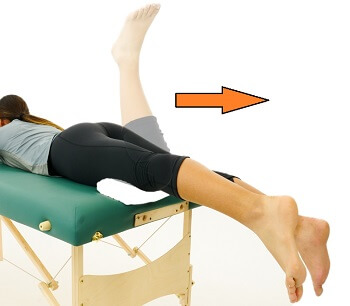
- Lie on your stomach, stiff knee bent, good leg straight, with a folded towel underneath your stiff knee
- Slowly let your stiff knee straighten so it hangs off the end of the bed
- Relax and let gravity gradually draw the knee down so it straightens further
- Hold this position for 30 seconds, bend the knee up and down a few times to loosen it back up and then repeat the exercise 10 times
Progression: If you are struggling to get those last few degrees of extension, wear an ankle weight or shoe to increase the stretch
For more ideas on how to reduce stiffness and knee pain on stairs, find out how to improve knee flexibility >
9. Plan Your Day
If you are really struggling with knee pain on stairs, you might want to think about limiting how often you go up and down stairs. Try to make sure you do everything you need to do upstairs before heading down in the morning, and that you bring down anything you might need. You can always put things in a backpack to keep your hands free for the rail/crutches.
If there are things that you need to do upstairs during the day, try to plan ahead and have a set period upstairs doing everything so you don’t have to keep going up and down.
10. Use A Knee Support or Brace
If the knee is feeling weak and sore, you might find that wearing tubigrip elasticated bandage or a knee support helps reduce instability and knee pain on stairs. Ideally this should only be a short time measure while you work on knee strengthening exercises.
Once you have built up the strength and endurance in the knee muscles, you shouldn’t need the extra support any more. Wearing a knee brace or support when you don’t need one can actually be counter-productive because it doesn’t get the muscles working as much so can lead to weakness.
How Else To Beat Knee Pain On Stairs
Here I have shared with you my top tips and tricks for getting up and down stairs with knee pain, tried and tested over 10 years as a physiotherapist. I hope that you find them useful.
But remember, it is really important to know what is causing your knee to hurt on stairs in the first place. Knee pain treatment will be slightly different depending on what is wrong – you may have a cartilage tear, arthritis, an inflamed bursa or something else entirely causing your knee pain on stairs. There are a number of different knee problems that can cause knee pain going up and down stairs. LEARN MORE >
So get checked out, follow the advice given here, do your exercises and take back control so you can beat knee pain on stairs.
Check Out Our Latest Book
"Beat Knee Pain: Take Back Control" tells you everything you need to know to help you work out what is wrong with your knee and gives you loads of great advice on how to get back to doing what you love. It has an average rating of 4.8/5 and is ranked the #2 Best Seller in Orthopedics on Amazon*.
*Ranked #2 Best Seller in Orthopedics (Kindle Store) on Amazon.com in October 2021
You may also be interested in the following articles:
- Pain Above The Knee
- Pain Behind The Knee
- Inner Knee Pain
- Knee Pain At Night
- Knee Swelling Causes & Treatment
- Knee Pain Diagnosis Chart
Page Last Updated: 01/02/24
Next Review Due: 01/02/26
Related Articles
References
- Journal of Orthopedic Research: Effective Gait Patterns for Offloading the Medial Compartment of the Knee. BJ Fregly, DD D'Lima & CW. Colwell, Jr. August 2009
- Journal of Engineering In Medicine: Knee Joint Forces: prediction, measurement, and significance. DD. D’Lima, BJ Fregly, S Patil, N Steklovand CWColwell, Jr. February 2012
